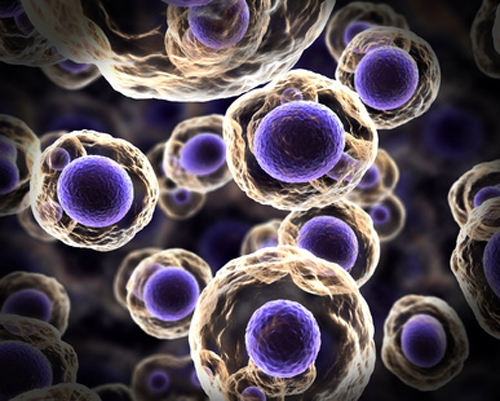Team says tip shape of nanowires, nanotubes, and asbestos fibers fools cells into thinking they are particles.
Cells can try and ingest materials such as carbon nanotubes or asbestos fibers that are actually too long to be fully engulfed because the shape of the tip fools the cells into thinking the structures are manageable spheres, researchers report. The cellular stress that results from incomplete or frustrated phagocytosis can then lead to the prolonged release of inflammatory mediators, cell death and, in the case of inhaled asbestos, DNA and chromosomal damage in the cells of the lung and pleura.
A Brown University team has now demonstrated that cells will try and internalize high aspect ratio, one-dimensional nanostructures such as cylindrical nanotubes—even if they are too long—when the structures have a rounded, capped tip. Their experimental and simulated studies showed that when the tip contacts the receptors on the cell surface, the cell assumes the overall structure is a particle, rotates it perpendicular to the cell surface to minimize the energy needed to take it in, and then tries to ingest it like a sword swallower.
This vertical geometry provides no opportunity for the cell membrane to sense or anticipate the ultimate length of the fibrous target material, explain Huajian Gao, Ph.D., Xinghua Shi, Ph.D., and colleagues. If the target fiber is too long for successful internalization and subsequent packaging in endosomes, the attempted intake will inevitably lead to incomplete endocytosis. Conversely, open-ended nanotubes will just lie along on the cell membrane, and the cell doesn’t try and engulf them.
Reporting in Nature Nanotechnology, the team says their findings could help with the design of safer biomedical products, and for understanding and regulating occupational and environmental exposure.
The researches focused on the interaction between cells and one-dimensional nanomaterials with a very high aspect ratio, such as carbon nanotubes, asbestos fibers, and gold nanowires. Their previous work, using in situ spinning disk confocal microscopy with dual fluorescence and polarized light imaging, had shown that multiwalled carbon nanotubes (MWCNT) entered cells tip first, but the mechanism was unclear. For their latest work the team used ex situ field-emission scanning electron microscopy (SEM) to obtain nanoscale resolution of the interaction and uptake of one-dimensional nanostructures by liver and mesothelial cells.
The images revealed a morphology characteristic of endocytosis, which was to be expected given that neither of the cell types is a professional phagocyte, and that the MWCNT tips have diameters of 50–100 nm, which is within the favorable size range for receptor-mediated endocytosis of particles, the researchers note. They also confirmed that carbon nanotubes undergoing entry are primarily found protruding from the cells at a high angle. Tip-first entry was also observed as the dominant uptake mode for other one-dimensional structures, including amine-terminated gold nanowires and asbestos fibers.
To try and figure out why this high-angle, tip-first entry is preferred, the team used coarse-grained molecular dynamics (CGMD) simulations of receptor-mediated endocytosis of capped MWCNTs through a model lipid bilayer. Based on previous modeling of endocytosis for spheres, they hypothesized that nanotube tips with closed, rounded caps can mimic particles and initiate endocytosis, and that it’s the elastic strain in the plasma membrane that provides the driving force to rotate one-dimensional nanostructures from their initial angle of contact to high angles that minimize total membrane elastic energy.
The resulting simulations showed that when an MWCNT contacts the bilayer at an angle of about 45 degrees, receptors in the layer aggregate around it and adhere to the MWCNT surface. However, as the tube is pulled into the bilayer and wrapped, it is rotated to achieve an entry angle close to 90 degrees. This rotation, they subsequently showed, is driven by membrane elastic energy minimization during wrapping. The simulations revealed that two competing kinetic processes are involved: rotation of the tube toward a 90 degree entry angle to relax energy in the membrane, and wrapping speeds on different sides of the tube governed by receptor diffusion. At higher receptor densities, the MWCNT may become fully wrapped before it reaches the 90 degree entry angle, and so be taken in at a shallower angle. Thus “the steady-state entry angle is determined by the competition between speed of tip rotation and that of receptor binding to side walls during uptake.”
The team repeated the simulations for different MWCNT diameters and lengths, receptor densities, receptor binding strengths, and initial entry angles, and found that the tube will still be preferentially positioned for a 90 degree entry pathway. Further experiments showed that the tip-entry mechanism is essentially unchanged if the hemispherical caps are replaced by enlarged shells typical of catalytically produced MWCNTs, or if the nanotubes exist in suspension as small bundles.
Conversely, the researchers found that open-ended nanotubes don’t undergo tip entry because they lack carbon atom sites for receptor binding on the cap in the early stages of wrapping. And if a capped MWCNT approaches the cell surface side-on, and the whole sidewall comes into contact with the membrane at once, the nanotubes seem to attach to the membrane without any visible signs of active uptake, they continue. This is possibly because of receptor depletion caused by the large contact area.
“Intelligent tip modification may provide new approaches in the future to engineer one-dimensional nanomaterials for cell delivery, or to avoid frustrated uptake and achieve material safety by design,” the team concludes. “Nanotubes without caps or shells on their tips show a different mode of membrane interaction, posing an interesting question as to whether modifying the tips of tubes may help avoid frustrated uptake by cells.”



